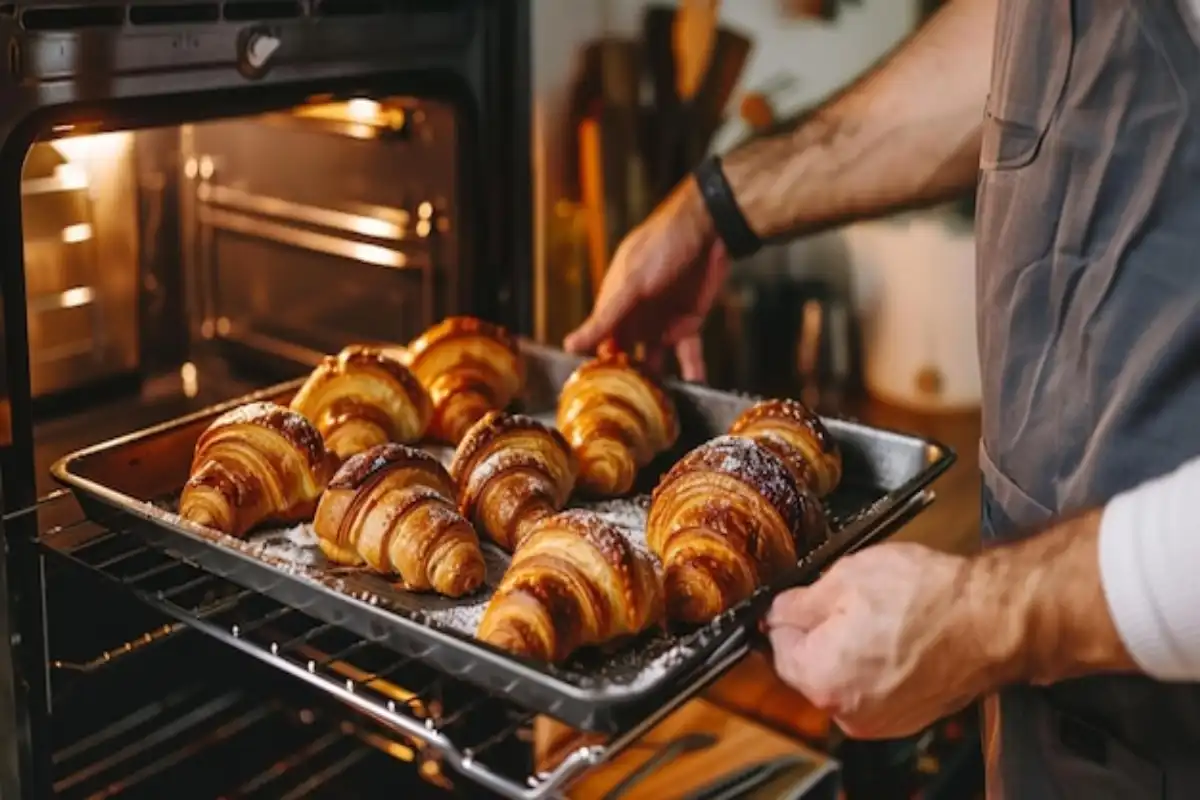Croissants are beloved for their delicate, flaky texture and buttery taste. Traditionally, people bake croissants in an oven, but what if you want to warm or toast one on a pan instead? Can you achieve the same delicious results? The answer is yes! Toasting a croissant in a pan can be a quick and efficient way to enjoy a crispy exterior and warm, soft interior without needing an oven. In this guide, we’ll walk you through how to properly toast a croissant on a pan, explain why it’s a wonderful option, and provide tips on enhancing the flavor with toppings.
Why Choose a Pan for Toasting Croissants?
1. Accessibility and convenience
One of the biggest advantages of using a pan to toast croissants is convenience. Not everyone has the time or access to an oven, especially when in a hurry or in a small kitchen setting. A stovetop and a non-stick pan, which most people have, are all you need to enjoy a toasty croissant in a matter of minutes.
Using a pan also avoids the need to preheat an oven or toaster oven. This means less waiting and less energy consumption. Additionally, using a pan allows you to monitor your croissant closely, ensuring it toasts to your preferred texture.
2. Greater Control Over Toasting
Toasting croissants in a pan allows you to control the heat and cooking process more effectively. Adjust the heat to avoid burning the croissant and flip it for even toasting. This method gives you more flexibility compared to using an oven or toaster.
Pan-toasting is especially useful if you want a crispy exterior while maintaining a soft, flaky inside. It’s perfect for when you want to elevate the texture of day-old or store-bought croissants.
For detailed guidance on temperatures for baking and toasting croissants, see this helpful article on the best temperatures for baking and toasting.
The Best Type of Croissant for Pan-Toasting
Not all croissants are ideal for pan-toasting, so choosing the right type can make a big difference in your results. Here’s what to look for:
1. Fresh vs. Day-Old Croissants
- Fresh croissants: If you’re toasting fresh croissants from a bakery, they’re already rich and flaky. Pan-toasting can enhance the crispiness on the outside while warming up the buttery layers on the inside.
- Day-old croissants: These are the perfect candidates for pan-toasting. Since croissants tend to dry out quickly, toasting them on a pan revives the texture, making them taste as fresh as new.
2. Frozen croissants
You can store and use frozen croissants whenever you need them. However, it’s essential to thaw them properly before toasting them in the pan. Placing frozen croissants directly on a pan may result in uneven toasting, leaving some parts cold or under-toasted.
For best results, follow the frozen croissant handling and baking tips to ensure your croissant thaws and toasts evenly.
3. Butter Content
When choosing a croissant for pan-toasting, higher butter content is key. The more butter in the croissant, the better it will toast, resulting in a golden-brown exterior and flaky layers inside. Avoid croissants made with margarine or lower-quality oils, as they may not crisp up as well or deliver the same rich flavor.
How to Properly Pan-Toast a Croissant
Now that you’ve chosen the perfect croissant, it’s time to pan-taste it. Follow these steps for the best results:
1. The Tools You’ll Need
- A non-stick pan will prevent the croissant from sticking and ensure even toasting.
- Spatula: To flip the croissant and move it around.
- Butter (optional): Adding a small amount of butter to the pan can enhance the flavor and help the croissant toast evenly.
2. Step-by-step instructions
Step 1: Preheat the pan.
Start by preheating your non-stick pan on medium heat. You don’t want the pan to be too hot, as this can cause the croissant to burn quickly on the outside while remaining cold on the inside. Even toasting can be done with medium heat.
Step 2: Slice the croissant
If you’re toasting a croissant with fillings like ham or cheese, slice it horizontally before placing it on the pan. Slicing helps the inside of the croissant toast evenly. However, if you prefer a softer interior with a crispy exterior, you can leave the croissant whole.
Step 3: Add Butter (Optional)
For added flavor, you can melt a small amount of butter in the pan before placing the croissant. This enhances the golden-brown color and gives the croissant an even richer taste.
Step 4: Toast the croissant
Place the croissant cut side down (if sliced) or directly on the pan. Let it toast for 2-3 minutes, checking frequently to prevent burning. If you prefer an extra crispy texture, you can flip the croissant and toast the other side for an additional 1-2 minutes.
For more detailed tips on toasting croissants, visit the Ultimate Guide to Croissant Toast.
Common Mistakes to Avoid When Pan-Toasting Croissants

Even with simple tasks like pan-toasting croissants, mistakes can happen. Here are some of the most common mistakes and how to avoid them:
1. Over-Toasting or Burning
Croissants can go from perfectly crispy to burnt in a matter of seconds, especially when toasted in a pan. Always monitor your croissant while toasting, and don’t leave it unattended. If you’re unsure, it’s better to undertook and add more time rather than risk burning.
2. Not preheating the pan properly.
Preheating the pan on medium heat is essential. If the pan is too hot, the croissant may burn quickly on the outside without warming up inside. On the other hand, a pan that isn’t hot enough will result in a soggy croissant.
3. Using Cold Croissants Without Thawing
If you’re working with frozen croissants, be sure to thaw them completely before toasting. Toasting a frozen croissant directly in the pan can result in uneven heating and a less-than-ideal texture. You can thaw frozen croissants overnight in the refrigerator or at room temperature for a few hours.
For more common toasting mistakes, see How to Toast the Perfect Croissant.
Delicious Toppings for Pan-Toasted Croissants
Pan-toasted croissants are already delicious on their own, but adding toppings can take them to the next level. Whether you prefer something sweet or savory, here are some creative topping ideas:
1. Sweet Toppings
- Jam or Marmalade: Spread your favorite jam or marmalade over the warm croissant. Classic flavors like strawberry, raspberry, or apricot pair well with the buttery croissant.
- Honey: Drizzling honey over a freshly toasted croissant adds a touch of sweetness without overpowering the pastry’s natural flavor.
- Nutella: For chocolate lovers, Nutella is the perfect accompaniment to croissants. The rich, creamy texture contrasts beautifully with the crispy, flaky layers of the croissant.
For more sweet topping ideas, check out creative croissant toppings.
2. Savory toppings
- Ham and Cheese: Turn your pan-toasted croissant into a savory sandwich by adding slices of ham and cheese. Toast the croissant with the filling inside to melt the cheese and create a gourmet breakfast option.
- Avocado and Egg: For a healthier twist, top your croissant with mashed avocado and a fried or poached egg. The creamy avocado complements the crispy croissant, while the egg adds protein.
3. Other Creative Pairings
- Fresh Fruit: For a refreshing balance of flavors, serve your croissant with slices of fresh fruit, such as strawberries, blueberries, or figs.
- For a unique and light breakfast, pair your croissant with a side of yogurt and granola.
For more inspiration on how to pair croissants with delicious recipes, see the Orange Juice Cake Recipe.
FAQs About Pan-Toasting Croissants
1. Can you toast frozen croissants in a pan?
Yes, you can toast frozen croissants in a pan, but it’s important to thaw them first. Toasting a frozen croissant without thawing will cause it to heat unevenly. Once thawed, follow the same steps for pan-toasting fresh croissants.
2. Do you need to add butter when pan-toasting a croissant?
It’s optional, but butter improves croissant flavor and crispness. If the croissant is already buttery, you can skip this step. However, a small amount of melted butter in the pan can give the croissant a golden, crispy finish.
3. How long does it take to toast a croissant in a pan?
Pan-toasting a croissant typically takes about 2-3 minutes per side. To avoid burning, check frequently and adjust the time based on your preference for crispiness.
4. What’s the best heat setting for pan-toasting croissants?
Medium heat is the ideal setting for pan-toasting croissants. This allows the croissant to toast evenly without burning on the outside or remaining cold on the inside.
5. Should you slice a croissant before pan-toasting?
If you’re adding fillings like ham, cheese, or spreads, you should slice the croissant before toasting. It ensures that the inside of the croissant toasts evenly. However, if you prefer a soft interior with a crispy exterior, you can leave the croissant whole.
Nutritional Value of Pan-Toasted Croissants
Pan-toasted croissants are delicious, but it’s worth noting that they’re also indulgent due to their high butter content. A standard croissant contains:
- Calories: 200-300 (depending on size and butter content).
- 12–15 grams of fat.
- Carbohydrates: 30 grams.
While croissants are high in calories and fat, they can be part of a balanced diet when enjoyed in moderation. For a healthier option, you can opt for whole-wheat or gluten-free croissants.
How to Store and Reheat Pan-Toasted Croissants
Storing leftover croissants
If you have leftover toasted croissants, store them in an airtight container at room temperature. They can last up to 1-2 days, but it’s best to re-toast them before eating to restore their crispiness.
Reheating Pan-Toasted Croissants
To reheat a croissant, place it in a preheated pan for 1-2 minutes per side or until warmed through. This method helps maintain the crispiness of the croissant. Avoid microwaving, as it can make the croissant soggy.
Conclusion
Toasting a croissant on a pan is not only possible, but it is also a fantastic way to enhance the texture and flavor of your croissant. Whether you’re working with fresh, day-old, or frozen croissants, pan-toasting is a quick and simple method that yields crispy, golden results.
With the right technique and toppings, you can turn a simple croissant into a gourmet treat. So, next time you’re craving a crispy croissant but don’t have access to an oven, grab a pan and enjoy this delightful pastry in minutes!
For more tips and tricks, be sure to visit the Ultimate Guide to Croissant Toast for detailed guidance.
